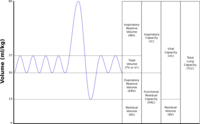
Photo from wikipedia
Objectives: Examine lung function, bronchial hyperresponsiveness (BHR) and exercise-induced respiratory symptoms in elite athletes performing different sports.Methods: Norwegian national-team athletes (30 swimmers, 32 cross-country skiers, 16 speed-skaters, 11 rowers/paddlers, 17… Click to show full abstract
Objectives: Examine lung function, bronchial hyperresponsiveness (BHR) and exercise-induced respiratory symptoms in elite athletes performing different sports.Methods: Norwegian national-team athletes (30 swimmers, 32 cross-country skiers, 16 speed-skaters, 11 rowers/paddlers, 17 handball players and 23 soccer players) completed a validated questionnaire, measured exhaled nitric oxide (FENO), spirometry, methacholine provocation (PD20met) and skin prick test. Three cut-off levels defined BHR; i.e., PD20met ≤2µmol, ≤4 µmol and ≤8µmol.Results: Mean forced vital capacity (FVC) was highest in swimmers (Mean z-score[95%CI] =1.16 [0.80, 1.51]), and close to or higher than reference values according to the Global Lung Initiative equation, across all sports. Mean forced expiratory volume in 1 second (FEV1) was higher than reference values in swimmers (0.48 [0.13, 0.84]), and ball game athletes (0.69 [0.41, 0.97]). Mean forced expiratory flow between 25 and 75% of FVC (FEF25-75), and/or FEV1/FVC were lower than reference values in all endurance groups. BHR defined by ≤2 and ≤8 µmol methacholine was observed in respectively 50%-87% of swimmers, 25%-47% of cross-country skiers, 20%-53% of speed-skaters, 18%-36% and of rowers/paddlers, and 0%-17% of the ball game athletes. Exercise-induced symptoms were common in all groups, most frequent in cross-country skiers (88%), swimmers (83%) and speed-skaters (81%).Conclusion: Elite swimmers and ball game athletes had higher mean FVC and FEV1, compared to reference values. However, FEF25-75 and/or FEV1/FVC was lower than the reference values in all endurance groups. The prevalence of BHR was high across all sports, except the ball game athletes, and most of the athletes reported exercise-induced respiratory symptoms.
Journal Title: European journal of sport science
Year Published: 2022
Link to full text (if available)
Share on Social Media: Sign Up to like & get
recommendations!